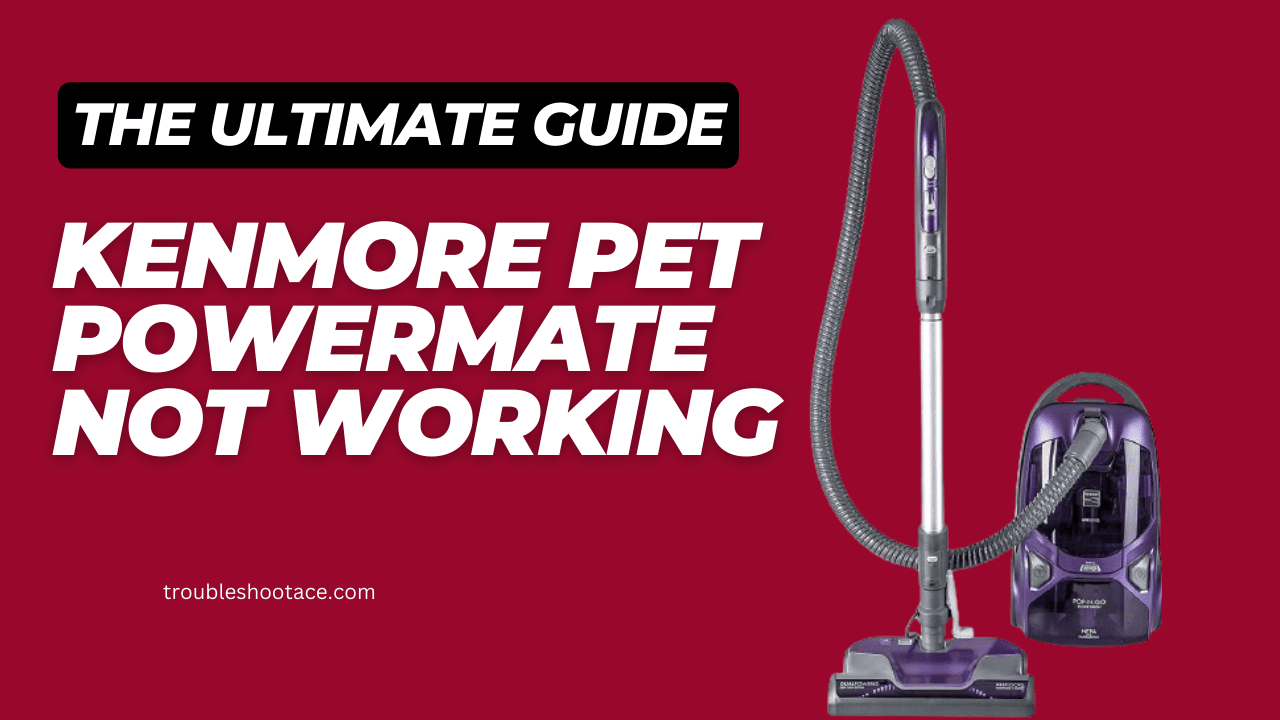Welcome, pet owners and cleaning enthusiasts! You’re in the right place if you are frustrated with a malfunctioning Kenmore Pet PowerMate not working. Your vacuum’s pet-centric ally is designed to conquer furry challenges, but when it falters, addressing the issue promptly becomes paramount.
In this guide, we’ll navigate the troubleshooting process together, unraveling the mysteries behind a non-functional Pet PowerMate. From reduced suction to brush malfunctions, we’ve covered you with practical tips and actionable steps. Let’s dive in and reclaim the power of your Kenmore Pet PowerMate.
Table of Contents
ToggleCommon Symptoms: Kenmore Pet Powermate Not Working
A. Lack of Suction
- Unplug and Inspect:
- Begin by unplugging the vacuum to ensure safety.
- Investigate the hose, nozzle, and any connections for potential blockages.
- Pay attention to the dustbin and filters; clean or replace them if necessary.
- Check for Clogs:
- Examine the hose and nozzle for trapped debris or pet hair.
- Utilize a vacuum cleaner attachment or a straightened coat hanger to clear any obstructions.
- Verify that the dustbin and filters are free of accumulated dirt, enabling optimal airflow.
B. Brush Not Spinning
- Inspect the Brush:
- Power down the vacuum and visually inspect the brush for any entangled hair or foreign objects.
- Use scissors or a utility knife to carefully cut away wrapped hair or fibers.
- Confirm that the brush spins freely after cleaning.
- Evaluate the Belt:
- Examine the belt connected to the brush for signs of wear or breakage.
- Replace the belt if it appears stretched, damaged, or slipping.
- Adjustments and Alignments:
- Ensure the brush height adjustment is suitable for the flooring type.
- Align the brush properly within its housing to prevent resistance.
C. Unusual Noises
- Identify the Source:
- Run the vacuum briefly to identify the specific location of the unusual noise.
- Investigate for loose parts, foreign objects, or debris causing the disturbance.
- Tighten Loose Components:
- Check for any loose screws, bolts, or attachments in the Pet PowerMate.
- Tighten any components contributing to the noise.
- Lubricate Moving Parts:
- Apply a small amount of vacuum-safe lubricant to rotating or moving parts to reduce friction and noise.
D. Other Visible Malfunctions
- Visual Inspection:
- Examine the Pet PowerMate for any visible damage, cracks, or loose connections.
- Address any issues found through simple repairs or replacements.
- Test Different Surfaces:
- Evaluate the performance of the Pet PowerMate on various surfaces to identify specific issues.
- Adjust settings accordingly to optimize functionality.
By systematically addressing these common symptoms, you can pinpoint the root cause of the Kenmore Pet PowerMate’s malfunction and take appropriate corrective actions. Remember to always prioritize safety by unplugging the vacuum before conducting any inspections or repairs.
Step-by-Step Troubleshooting Guide

A. Disconnect and Inspect
In the initial step of troubleshooting your Kenmore Pet PowerMate not working, it is imperative to prioritize safety by completely powering off and unplugging the vacuum. Once this precautionary measure is taken, the focus shifts to a thorough inspection of potential culprits causing malfunctions.
Begin by scrutinizing the hose, nozzle, and other vacuum attachments for any signs of blockages or clogs. Employ vacuum attachments, a straightened coat hanger, or appropriate tools to delicately clear any obstructions hindering optimal suction.
B. Power Source
Moving on to the next critical phase in troubleshooting your Kenmore Pet PowerMate, it’s time to address the power source. Begin by verifying the secure connection of the Pet PowerMate to the vacuum. Confirm that the components are tightly and correctly attached to ensure a seamless power flow.
Simultaneously, inspect the power cord and its connections for any visible damage or wear. Should any issues be detected, it is advisable to replace damaged cords promptly to reinstate a reliable power supply.
As part of this power source assessment, it is also prudent to test the functionality of the power outlet itself. Use another device to ensure the outlet is operational, ruling out any external factors contributing to the PowerMate’s malfunction.
C. Brush and Belt Examination
Turning our attention to the heart of the Kenmore Pet PowerMate, let’s examine the brush and belt. Start by powering off the vacuum and inspecting the brush for entangled pet hair or debris. A clean, obstruction-free brush ensures optimal performance. If the brush shows signs of wear, consider replacement.
Next, scrutinize the belt connected to the brush. Check for wear, stretching, or breakage, and replace if necessary. Ensure the brush height suits your flooring type, and align it properly to prevent resistance. This swift examination of the brush and belt ensures your Kenmore Pet PowerMate is ready to handle pet hair and maintain peak performance efficiently.
D. Motor Inspection
Now, let’s delve into the crucial motor inspection, a pivotal component of your Kenmore Pet PowerMate. A malfunctioning motor can lead to a range of issues, from reduced suction to overheating. Here’s a step-by-step guide for a thorough motor inspection:
- Evaluate for Overheating: Begin by running the vacuum for a brief period and check if the motor becomes excessively hot. Overheating can signal issues with airflow or potential motor problems.
- Clean or Replace Motor Filter: Inspect the motor filter for accumulated dirt and debris. A clogged filter can restrict airflow, leading to motor strain.
- Troubleshoot Motor-Related Issues: If the motor continues to malfunction, consult your user manual for model-specific troubleshooting steps. It may include additional checks or recommendations to identify and resolve motor-related issues.
By thoroughly examining the motor and addressing any potential issues, you’re ensuring the longevity and efficiency of your Kenmore Pet PowerMate. Regular maintenance of the motor and associated components is key to sustaining optimal suction power and overall performance.
E. Addressing Unusual Noises
When confronted with unusual noises emanating from your Kenmore Pet PowerMate, a systematic approach to identify and address the source is crucial. Follow these steps to restore a quieter operation:
- Identify the Source of the Noise: Run the vacuum briefly to pinpoint the location of the unusual sounds. Pay close attention to any specific areas or components contributing to the noise.
- Tighten Loose Parts or Screws: Conduct a thorough examination for loose screws, bolts, or attachments within the Pet PowerMate. Tighten any components contributing to the noise to ensure a secure and stable operation.
- Lubricate Moving Components: Apply a small amount of vacuum-safe lubricant to rotating or moving parts. This helps reduce friction, eliminating squeaks or creaks caused by dry components.
By addressing unusual noises promptly, you not only enhance the overall user experience but also prevent potential damage to the Pet PowerMate. A quieter operation ensures efficient cleaning without any distracting disturbances, allowing you to enjoy the full capabilities of your Kenmore Pet PowerMate.
Conclusion
In conclusion, troubleshooting and addressing issues with your Kenmore Pet PowerMate not working can significantly enhance its longevity and effectiveness in tackling pet hair and debris. By systematically disconnecting, inspecting, and addressing common symptoms like lack of suction, brush malfunction, unusual noises, and motor issues, you empower yourself to maintain optimal performance.
Remember, a well-maintained Pet PowerMate not only keeps your living spaces clean but also contributes to a harmonious coexistence with your beloved furry friends.

